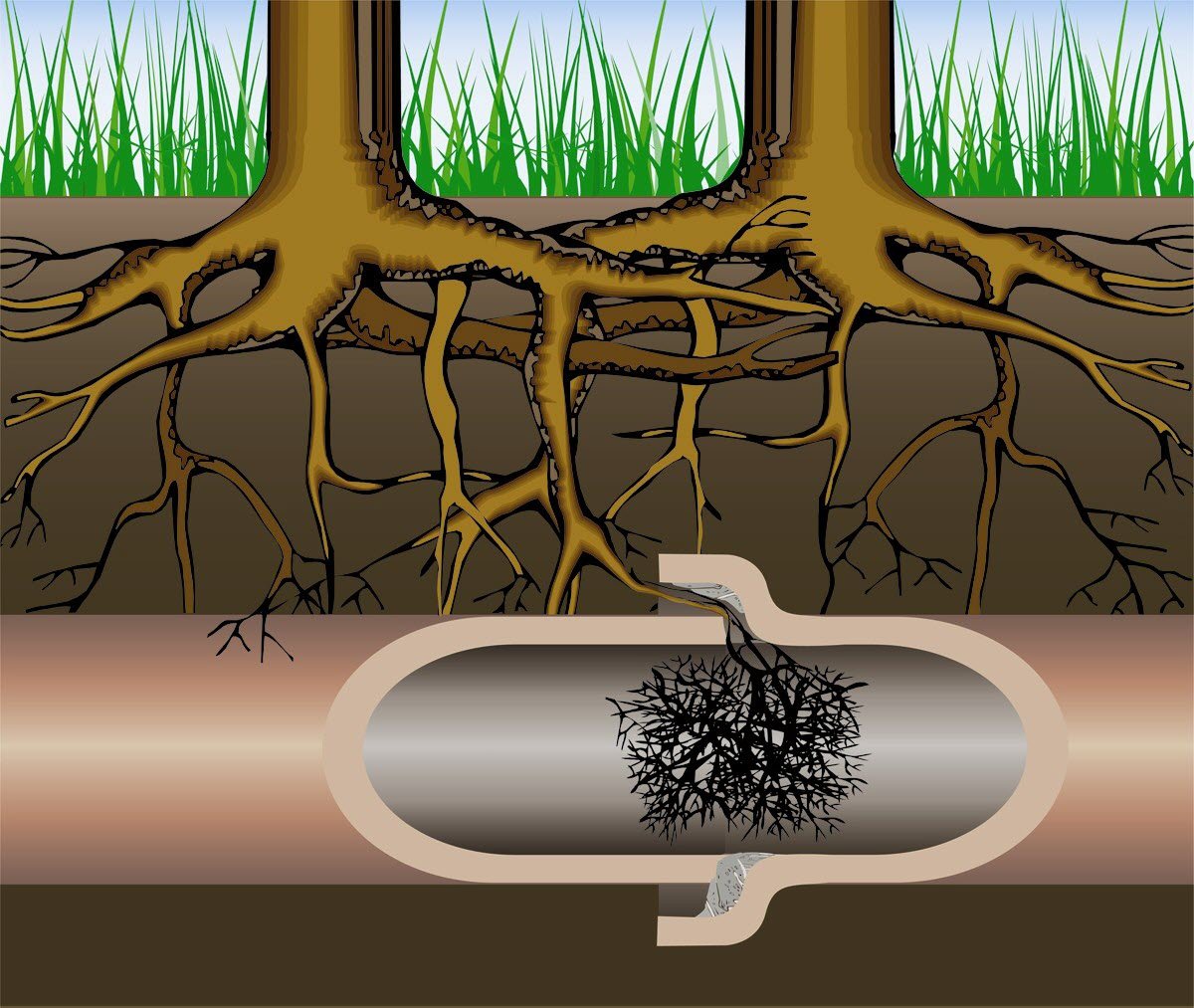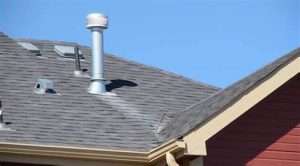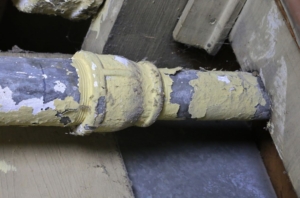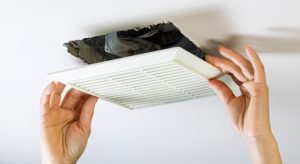Roots in Sewer Lines: Understanding the Problem
and Finding Effective Solutions Roots

Roots in Sewer Lines: Understanding the Problem and Finding Effective Solutions Roots in sewer line can cause serious problems for homeowners. When tree or plant roots grow into the sewer line, they can cause blockages, backups, and even damage to the pipes. The problem is common, but it’s not something you should ignore. If left untreated, roots in your sewer line can lead to costly repairs. This blog post will provide valuable information on the causes, symptoms, and solutions for roots in your sewer line. Whether you’re experiencing a problem now, or just want to prevent future issues, you’ll find the answers here.
What are Roots in Sewer Lines?
Understanding the Problem
Roots in sewer lines can be a major headache for homeowners and can lead to costly repairs if left untreated. In this section, we will explore what exactly roots in sewer lines are and why they can cause such issues.
How do Roots Get into Sewer Lines?
To understand how roots get into sewer lines, it’s important to know that sewer lines are typically made of pipes buried underground. Over time, small cracks or gaps can develop in these pipes, and this is where roots come into play. Tree roots are naturally attracted to sources of water and nutrients, and sewer lines can provide the perfect environment for them to thrive.
When there are cracks or gaps in the sewer line pipes, roots can sense the moisture and nutrients inside. They start to grow towards these openings, gradually infiltrating the pipes. Once inside, the roots continue to grow and expand, causing blockages and damaging the pipes.
The Dangers of Roots in Sewer Lines
Roots in sewer lines can wreak havoc on your plumbing system. Here are some of the dangers they can present:
- Blockages: As roots continue to grow inside the pipes, they can create blockages that prevent wastewater from flowing freely. This can lead to backups, causing water to back up into your home or yard.
- Pipe Damage: The pressure exerted by growing roots can cause pipes to crack, collapse, or become misaligned. This can result in leaks, reduced water flow, and further blockages.
- Expensive Repairs: Repairing sewer line damage caused by roots can be a costly endeavor. In some cases, entire sections of pipes may need to be replaced, which can require extensive excavation and disruption to your property.
- Health Risks: Sewer backups caused by root blockages can expose you and your family to harmful bacteria and pathogens. This can pose a significant health risk and require professional cleaning and sanitization.
Signs of Root Intrusion
Root intrusion in sewer lines can cause significant damage and lead to costly repairs if left unaddressed. Identifying the signs of root intrusion early on can help homeowners take prompt action and prevent further complications. In this section, we will discuss three common signs of root intrusion: slow draining fixtures, gurgling noises in drains, and sewage backups.
Slow Draining Fixtures
One of the first signs that roots may be causing problems in your sewer line is when you notice slow draining fixtures. This can include sinks, showers, toilets, and other drains in your home. If you find that water takes longer than usual to drain or that it struggles to go down the drain completely, it could be an indication of root intrusion.
Roots have a tendency to grow into cracks or joints in sewer pipes, obstructing the flow of wastewater. As a result, water can accumulate and create blockages, leading to slow drainage. If you experience this issue consistently across multiple fixtures in your home, it’s essential to have your sewer line inspected to determine if root intrusion is the cause.
Gurgling Noises in Drains
Another telltale sign of root intrusion is the presence of gurgling noises in your drains. If you hear unusual sounds when water is draining from sinks, tubs, or toilets, it could indicate that roots have infiltrated your sewer line. As the water tries to pass through the obstructed pipe, it can cause air bubbles to form, resulting in gurgling sounds.
These noises typically occur when there is a partial blockage caused by roots. While gurgling drains may not seem like a significant issue at first, it’s crucial to address the root cause promptly. Ignoring the problem can lead to more severe blockages, potentially causing sewage backups and extensive damage to your plumbing system.
Sewage Backups
One of the most alarming signs of root intrusion is a sewage backup. If you notice wastewater backing up into your sinks, showers, or toilets, it’s a clear indication that there is a significant problem in your sewer line. Roots can completely obstruct the flow of sewage, causing it to back up into your home.
Sewage backups pose health risks and require immediate attention. The presence of raw sewage in your living space can contaminate your home and expose you to harmful bacteria. It’s crucial to contact a professional plumber as soon as possible to assess the extent of the root intrusion and perform the necessary repairs.
Causes of Root Intrusion
Root intrusion is a common and frustrating problem that many homeowners face when it comes to their sewer lines. The invasion of roots into the sewer pipes can cause blockages, backups, and even structural damage to the plumbing system. Understanding the causes of root intrusion is crucial in preventing and addressing this issue effectively. In this section, we will explore the three main factors that contribute to root intrusion: cracks and joints in pipes, a warm moist environment, and a nutrient-rich environment.
Cracks and Joints in Pipes
One of the primary reasons why roots find their way into sewer lines is through cracks and joints in the pipes. Over time, aging and deteriorating pipes can develop small openings, providing an entry point for roots to grow into. Even the tiniest crack or gap can be an invitation for roots seeking water and nutrients. As roots continue to grow, they can exert pressure on the pipes, causing further damage and ultimately leading to blockages. Regular inspections and maintenance of sewer lines can help identify and repair any cracks or joints, minimizing the risk of root intrusion.
Warm Moist Environment
Another crucial factor that attracts roots to sewer lines is the warm and moist environment inside the pipes. Sewer lines provide the perfect conditions for roots to thrive and grow, with a constant supply of moisture and a relatively stable temperature. The warmth and humidity within the pipes create an inviting habitat for roots to establish themselves. As they grow, they can infiltrate the pipes, causing obstructions and clogs. Taking preventive measures such as maintaining proper drainage and ventilation can help reduce the appeal of your sewer lines to roots.
Nutrient-Rich Environment
In addition to cracks and a suitable environment, sewer lines offer a nutrient-rich environment that entices roots to invade. As wastewater flows through the pipes, it carries organic matter and nutrients that act as a food source for roots. The presence of these nutrients attracts root growth and encourages them to extend their reach into the pipes. Regular sewer line maintenance, including the removal of any organic debris, can reduce the likelihood of root intrusion by depriving them of the nourishment they need to thrive.
Prevention and Maintenance
Regular maintenance and proper prevention techniques are crucial in ensuring the health and longevity of your sewer line. By taking proactive measures, you can prevent roots from infiltrating your pipes and causing costly and frustrating plumbing issues. In this section, we will discuss three key strategies for preventing root intrusion: regular maintenance and inspections, proper tree and shrub placement, and chemical treatments.
Regular Maintenance and Inspections
One of the most effective ways to prevent root intrusion is through regular maintenance and inspections of your sewer line. By scheduling routine checks, you can identify potential issues early on and take necessary actions to prevent further damage.
During inspections, professional plumbers use specialized cameras to assess the condition of your pipes. These inspections help identify any signs of root intrusion, such as cracks, blockages, or weakened pipes. By catching these problems early, you can address them promptly and avoid more extensive damage.
Proper Tree and Shrub Placement
Careful consideration of tree and shrub placement can significantly reduce the risk of root intrusion into your sewer line. When planting trees and shrubs near your property, it is essential to choose species with non-invasive root systems.
Some trees and shrubs, such as willows, poplars, and silver maples, have aggressive and expansive root systems that are more likely to penetrate pipes. Instead, opt for species like dogwoods, crepe myrtles, or Japanese maples, which have less invasive roots.
Furthermore, maintain a safe distance between your trees and shrubs and the sewer line. The general rule of thumb is to plant them at least 10 feet away from any underground pipes or utilities. By providing ample space, you minimize the chances of root growth reaching and damaging your sewer line.
Chemical Treatments
Chemical treatments can be an additional preventive measure against root intrusion. These treatments involve using specially formulated chemicals that discourage root growth near sewer lines.
One common chemical treatment is copper sulfate, which is toxic to roots. When applied to the soil surrounding your sewer line, copper sulfate creates an inhospitable environment for root growth. However, it is important to note that excessive use of copper sulfate can harm other plants and trees in your yard, so it should be used sparingly and with caution.
Another alternative is foaming root killers. These products contain herbicides that coat the inside of your pipes and inhibit root growth. Regularly using foaming root killers can prevent root intrusion and help maintain the integrity of your sewer line.
Removing Roots from Sewer Lines
Roots in sewer lines can cause major problems for homeowners, leading to clogs, backups, and even pipe damage. If you’re dealing with this issue, it’s important to take action promptly to prevent further damage and ensure the smooth flow of wastewater. In this section, we will explore two effective methods for removing roots from sewer lines: mechanical removal and chemical removal.
Mechanical Removal Methods
Mechanical removal methods involve physically cutting or removing the roots from the sewer lines. These methods are typically performed by professionals and require specialized equipment. Here are some commonly used mechanical removal methods:
- Root Cutting Machines: Also known as root saws or root augers, these machines use rotating blades or cutting heads to slice through the roots and clear the blockage. They are effective in removing large, stubborn roots that have infiltrated the pipes.
- Hydro Jetting: This method involves using high-pressure water to blast away the roots and debris from the sewer lines. Hydro jetting not only removes the roots but also cleans the pipes, improving their overall condition.
- Root Ball Removal: In cases where the roots have formed a solid mass or ball inside the pipe, specialized tools are used to break up and extract the root ball. This method ensures complete removal of the roots, minimizing the chances of regrowth.
Chemical Removal Methods
Chemical removal methods involve using root-killing chemicals to eliminate the roots from the sewer lines. These chemicals are typically available in granular or liquid form and are designed to inhibit root growth. Here are some commonly used chemical removal methods:
- Copper Sulfate: Copper sulfate is a popular choice for root control. It is poured into the toilet or drain and flushed into the sewer lines. The chemical kills the roots on contact and prevents further growth. However, it may take several applications to achieve effective results.
- Foaming Root Killers: Foaming root killers are applied directly to the sewer lines through a cleanout or toilet. The foam expands and clings to the pipe walls, ensuring maximum contact with the roots. These products contain powerful chemicals that kill the roots and inhibit regrowth.
- Herbicide Treatments: Herbicides specifically formulated for root control can be effective in killing and preventing root growth in sewer lines. These treatments are typically performed by professionals who have the expertise to apply the herbicides safely and effectively.
Remember, chemical removal methods should be used with caution and only as a last resort. It’s important to follow the manufacturer’s instructions and take necessary safety precautions when using these products.
Repairing Sewer Lines Damaged by Roots
In the constant battle between nature and infrastructure, sewer lines often fall victim to the relentless growth of tree roots. This can lead to blockages, leaks, and even complete pipe failure. However, there are effective solutions available for repairing sewer lines damaged by roots. Two commonly used methods are pipe relining and pipe replacement.
Pipe Relining
Pipe relining is a modern and innovative technique used to repair sewer lines without the need for extensive excavation. This method involves creating a new pipe within the existing damaged pipe, eliminating the need to dig up the entire line. It is a cost-effective option that can save both time and money.
The process of pipe relining starts with a thorough inspection of the sewer line using specialized cameras. This helps identify the exact location and extent of the root intrusion. Once the assessment is complete, the damaged pipe is cleaned and cleared of any debris or roots. Then, a flexible liner coated with epoxy resin is inserted into the pipe.
The liner is inflated, allowing the resin to adhere to the inner walls of the damaged pipe. After a few hours, the resin hardens, creating a durable and seamless new pipe within the old one. This new pipe is resistant to root intrusion and has a longer lifespan than traditional pipes.
Pipe relining offers several advantages. It requires minimal excavation, causing less disruption to the surrounding landscape and reducing the overall cost of the repair. It is a quick process that can be completed in a matter of days, ensuring minimal inconvenience to homeowners. Additionally, the new pipe created through relining is smooth, which improves water flow and reduces the likelihood of future blockages.
Pipe Replacement
In cases where the damage caused by roots is extensive or the existing pipe is beyond repair, pipe replacement becomes necessary. Although it is a more invasive and time-consuming process compared to pipe relining, it can be the best solution for severely damaged sewer lines.
Pipe replacement involves excavating the affected area and removing the damaged pipe entirely. This is followed by the installation of a new pipe made of durable materials such as PVC or HDPE. The new pipe is resistant to root intrusion and can withstand the test of time.
While pipe replacement may require more effort and resources, it offers long-term benefits. It ensures a completely new and reliable sewer line, eliminating the risk of recurring root intrusion. Moreover, modern pipe materials used in replacement are designed to withstand the pressure and stress of underground conditions, providing a more robust solution.
Hiring a Professional
Choosing the right plumbing service and obtaining accurate quotes and estimates are crucial steps when dealing with root problems in your sewer line. To ensure a smooth and efficient resolution to your plumbing issues, it’s important to hire a professional who is experienced, reliable, and knowledgeable. In this section, we will discuss the key factors to consider when selecting a plumbing service and the importance of obtaining accurate quotes and estimates.
Choosing the Right Plumbing Service
When it comes to addressing root problems in your sewer line, it’s essential to choose a plumbing service that specializes in this area. Not all plumbers have the expertise or equipment necessary to effectively tackle root intrusion. Look for a plumbing company that has a proven track record in dealing with similar issues and has experienced professionals who understand the complexities of root-related plumbing problems.
Consider the following factors when choosing a plumbing service:
- Reputation and Reviews: Research the company’s reputation and read customer reviews. A reputable plumbing service will have positive feedback from satisfied customers, indicating their reliability and quality of work.
- Licensing and Insurance: Ensure that the plumbing service is licensed and insured. This not only protects you in case of any mishaps but also demonstrates the company’s commitment to professionalism and compliance with industry standards.
- Availability and Responsiveness: Emergencies can happen at any time, so it’s important to choose a plumbing service that offers 24/7 availability and prompt response times. This ensures that you can get immediate assistance when needed, minimizing the potential damage caused by root intrusion.
- Warranty and Guarantees: Inquire about the warranty and guarantees provided by the plumbing service. A reputable company will stand behind their work and offer warranties on both the materials used and the services performed.
Obtaining Quotes and Estimates
Before hiring a plumbing service, it’s crucial to obtain accurate quotes and estimates for the work to be done. This helps you understand the potential costs involved and allows for effective budgeting. Here are the steps to follow when obtaining quotes and estimates:
- Request Multiple Quotes: Reach out to multiple plumbing services and request quotes for the job. This allows you to compare prices and services offered, ensuring you get the best value for your money.
- Provide Detailed Information: Be as specific as possible when describing the root problem in your sewer line. This will enable the plumbing service to provide a more accurate estimate, taking into account the complexity of the issue and the necessary repairs or replacements.
- Ask for a Written Estimate: Insist on receiving a written estimate that outlines the scope of work, materials to be used, and the total cost involved. A written estimate protects both you and the plumbing service by ensuring there are no misunderstandings or disputes later on.
- Clarify Additional Charges: Inquire about any additional charges that may be incurred during the repair process. It’s important to have a clear understanding of all potential costs, including any unforeseen issues that may arise during the job.
Conclusion
Dealing with roots in your sewer line can be a frustrating and inconvenient problem to face. Regular maintenance, such as using root-killing products and scheduling professional inspections, can help you identify and address root issues before they become major headaches. Additionally, considering alternative sewer line materials like PVC can provide a long-term solution to this recurring problem. By staying proactive and implementing these strategies, you can keep your sewer line free from pesky roots and ensure the smooth functioning of your plumbing system for years to come.





